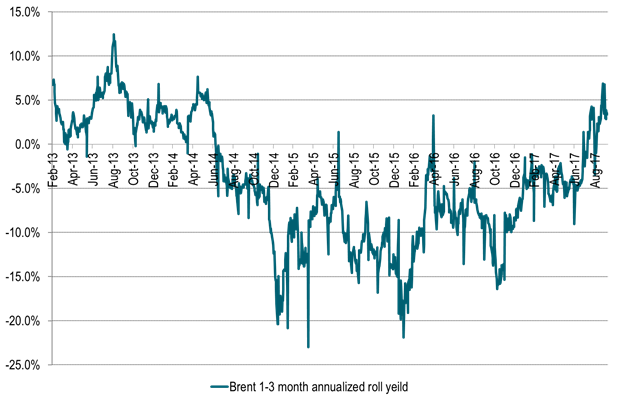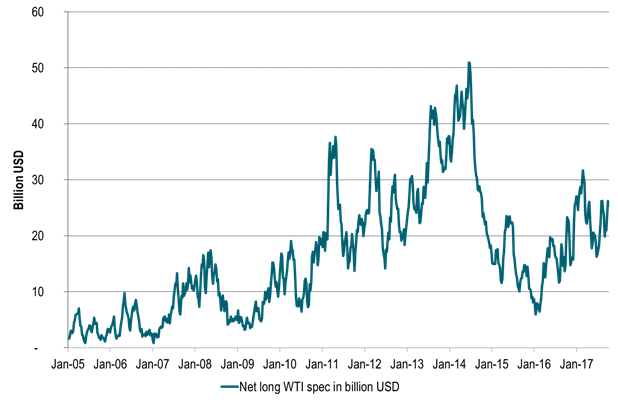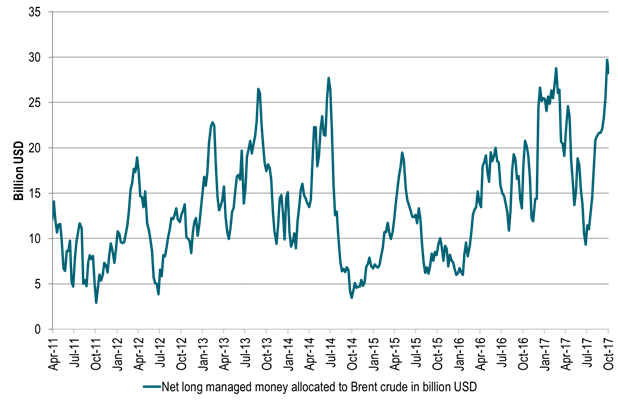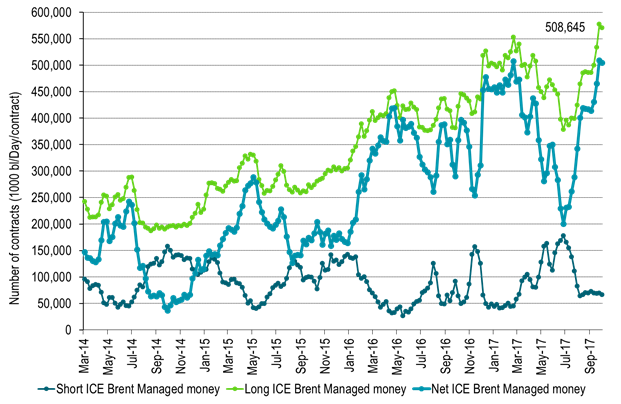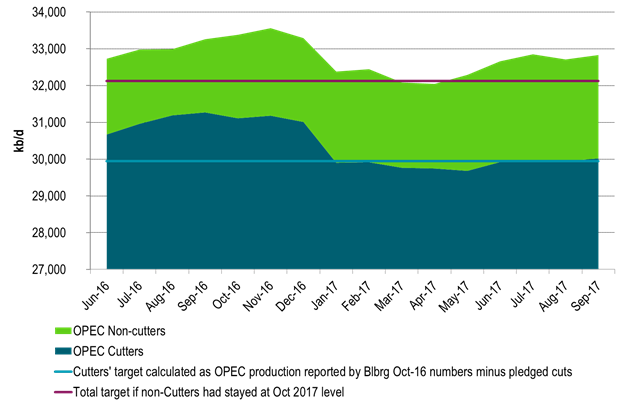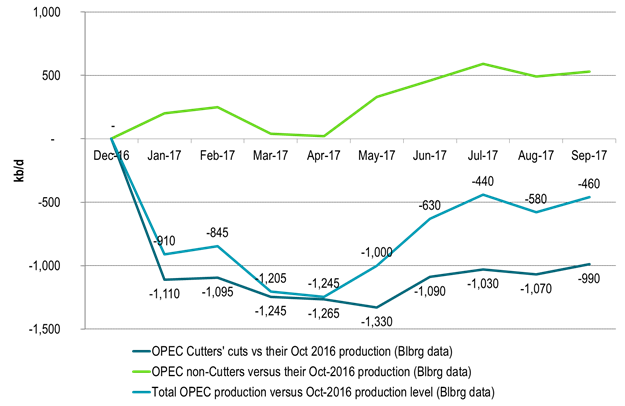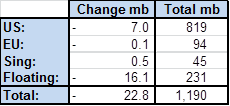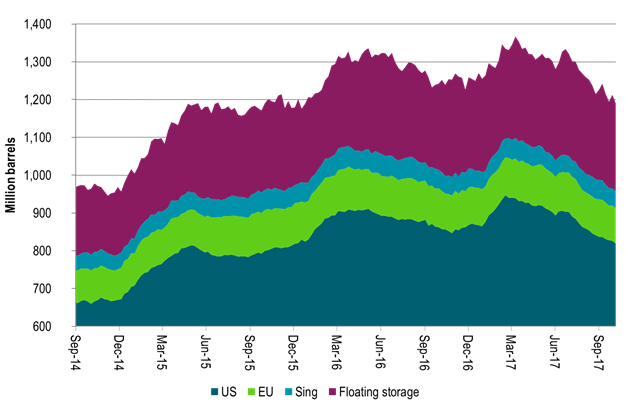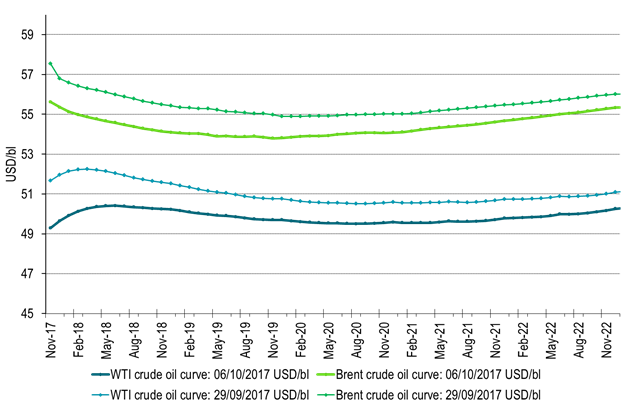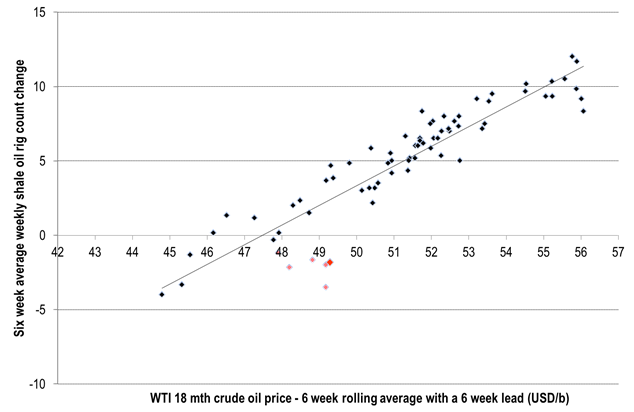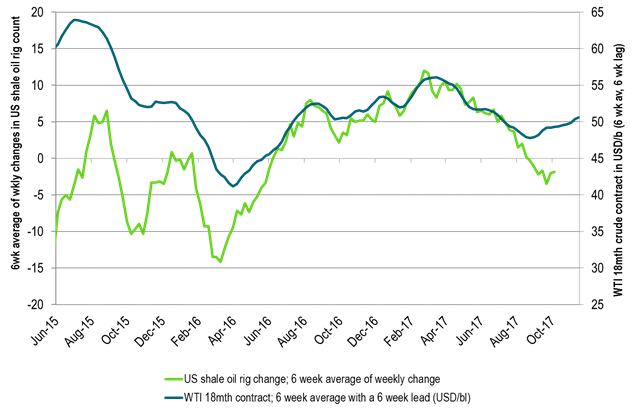Analys
Market at unease over high Brent specs and OPEC+ 2018 decision but Brent backwardation should attract yet more long Brent specs

 OPEC compliance is back in focus as compliance fell in September to 990 kb/d of cust versus a pledge of 1200 kb/d for the cutters. OPEC’s meeting on November 30th in Vienna thus coming into focus. Market is concernd for oil market balance in 2018 and is starting to feel at unease over whether OPEC+ will cut all through 2018 or not. We think they need to but we also think they will.
OPEC compliance is back in focus as compliance fell in September to 990 kb/d of cust versus a pledge of 1200 kb/d for the cutters. OPEC’s meeting on November 30th in Vienna thus coming into focus. Market is concernd for oil market balance in 2018 and is starting to feel at unease over whether OPEC+ will cut all through 2018 or not. We think they need to but we also think they will.
Brent net long managed money reached a record high level the week before last. It fell back only marginally last week. Brent crude is thus at risk to the downside if speculators/investors decides to take yet more money off the table. Thus correction since Brent 1mth reached a new ytd high the week before last may not be over. The general backdrop for Brent does however continue to be positive. The global financial and economic backdrop is positive. Oil inventories continues to decline on the back of strong oil demand growth and cuts by OPEC+ with the result that Brent backwardation should continue to strengthen. Thus even if we see a correction in Brent now driven by speculative money we should see more money heading for Brent long specs going forward. Not less.
From Friday to Friday the Brent Dec-17 contract lost 2.9% closing the week at $55.62/b. The longer dated contract Brent Dec-2020 lost 1.7% with a close of $54.06/b.
Last week’s sell-off was clearly a continuation of the sell-off that kicked in when Brent crude front month reached a new year to date high the week before last when it printed $59.49/b.
To us the sell-off seems technically driven as a counter reaction to Brent crude front month reaching a new year to date high. Net long Brent speculative positions reached its highest historical level in the week before last (records back to 2011) while it fell back marginally last week. With such high levels it does not take much for a correction to take place.
The general back-drop last week was positive with global equities gaining 1%, industrial metals gaining 2.4% while natural gas and coal gaining 3.8% (ARA coal Dec-18) and 1% (EU gas Q4-18).
On oil specifics we saw US crude, distillates and gasoline stocks declining 7 mb while global floating storage of crude and products fell 16 mb. In sum there were a lot of supportive winds last week but Brent crude countered it with a continued to sell off as record high specs took money off the table in a technical reaction to the high print of the year in the week before last.
This morning Brent crude has been trading in positive and negative territory but clos to unchanged and undecided.
In focus this morning is OPEC compliance for September which fell back slightly from August. The members with pledges delivered a cut of 990 kb/d of in September versus pledges of 1.2 mb/d. The OPEC producers with no obligations to cut have increased production by 530 kb/d (versus their October production). In effect OPEC’s total cuts versus its 2017 October level only amounted to 460 kb/d in September.
This is negative since it not a lot. It is positive since inventories are falling rapidly despite the fact that OPEC in total is not cutting a lot. However, the 990 kb/d held back by the cutters in OPEC in September will move back into the market at some point in time in the future again.
Some concern now is that OPEC’s exports will rise since the peak domestic oil demand in OPEC is behind us. In addition refineries will move off-line for autumn maintenance also reducing off-take for crude. OPEC’s upcoming meeting on Nov 30th is putting the spot light back on the 2018 balance. Will they or won’t they roll cuts beyond 1Q18? In our view it is needed and that view is shared by many. Our view is also that they will roll cuts forward since the magnitude of needed cuts is manageable. However the issue creates unease in the market as we run towards the Nov 30th meeting and proper decision by OPEC (+ Russia etc) some time in 1Q18.
Have we now come to the end of the correction we have seen the last two weeks? Brent speculative positions are still close to record high with room to pull more money off the table. However, the backdrop is still fairly positive as inventories continue to draw down which should be supportive for further strengthening of the backwardation of the Brent crude forward curve which is attractive for long positions.
In our view the Backwardation of the Brent crude forward curve is likely to continue to attract yet more money into additional net long speculative positions. This is because the backwardation hands investors/speculators a positive roll yield even if the Brent front month only trades sideways. And as we see in the rest of financial markets there is lots of money chasing yield in a low yield world. Over the past 20 trading days the Brent backwardation measured on the back of the 1-3 mth Brent time spread has averaged an annualized positive roll yield of +3.9%.
Thus despite the fact that net long Brent spec is close to record high we should see more passive money being allocated to Brent long positions. As long as inventories continue to draw down as they currently do with further strengthening of the Brent backwardation. As long as alternative yields around the world is very low as they are. As long as the general global growth outlook looks positive as it does with strong oil demand growth. Yes then we should see more long specs heading to Brent.
The current sell-off may thus not be too deep. The general backdrop is positive. Inventories are declining. Brent backwardation is likely to strengthen further and yet more passive money is likely going to head the Brent long positions.
Ch1: Brent 1-3 mth annualized roll-yield in the positive – Attracting long specs
Passive money likely to continue to roll into long front end Brent positions with a positive roll yield
Ch2: WTI oil in dollar allocation still well below prior highs
But the WTI curve is in contango so no rush to enter additional longs there
Ch3: Brent net long allocation recently reached record high of close to USD 30 billion
Thus plenty of room for a pull-back as we have seen the last two weeks
But Brent backwardation is likely to lure yet more passive long allocations to Brent front end contracts
Ch4: Brent net long managed money allocations at uncomfortable high levels
Ch5: Brent net long managed money allocations at uncomfortable high levels
Ch6: OPEC cutters delivered close to promissed cuts even though they inched slightly higher in Sep
Ch7: OPEC cutters and no-cutters. Net cuts of only 460 kb/d. But cutters deliver close to target
Ch8: OPEC total production. Not cutting all that much. Ytd YoY OPEC’s production is down only 115 kb/d
Ch9: Inventories continue to fall in weekly data
Ch10: Crude forward curves. Sell-off along the curve but Brent still in backwardation
Ch11: US oil rig count down by 2 last week
Ch12: US shale oil rigs count change. Price – rig relationship not what it used to be
Kind regards
Bjarne Schieldrop
Chief analyst, Commodities
SEB Markets
Merchant Banking
Analys
Diesel concerns drags Brent lower but OPEC+ will still get the price it wants in Q3

Brent rallied 2.5% last week on bullish inventories and bullish backdrop. Brent crude gained 2.5% last week with a close of the week of USD 89.5/b which also was the highest close of the week. The bullish drivers were: 1) Commercial crude and product stocks declined 3.8 m b versus a normal seasonal rise of 4.4 m b, 2) Solid gains in front-end Brent crude time-spreads indicating a tight crude market, and 3) A positive backdrop of a 2.7% gain in US S&P 500 index.

Brent falling back 1% on diesel concerns this morning. But positive backdrop may counter it later. This morning Brent crude is pulling back 0.9% to USD 88.7/b counter to the fact that the general backdrop is positive with a weaker USD, equity gains both in Asia and in European and US futures and not the least also positive gains in industrial metals with copper trading up 0.4% at USD 10 009/ton. This overall positive market backdrop clearly has the potential to reverse the initial bearish start of the week as we get a little further into the Monday trading session.
Diesel concerns at center stage. The bearish angle on oil this morning is weak diesel demand with diesel forward curves in front-end contango and predictions for lower refinery runs in response this down the road. I.e. that the current front-end strength in crude curves (elevated backwardation) reflecting a current tight crude market will dissipate in not too long due to likely lower refinery runs.
But gasoline cracks have rallied. Diesel weakness is normal this time of year. Overall refining margin still strong. Lots of focus on weakness in diesel demand and cracks. But we need to remember that we saw the same weakness last spring in April and May before the diesel cracks rallied into the rest of the year. Diesel cracks are also very seasonal with natural winter-strength and likewise natural summer weakness. What matters for refineries is of course the overall refining margin reflecting demand for all products. Gasoline cracks have rallied to close to USD 24/b in ARA for the front-month contract. If we compute a proxy ARA refining margin consisting of 40% diesel, 40% gasoline and 20% bunkeroil we get a refining margin of USD 14/b which is way above the 2015-19 average of only USD 6.5/b. This does not take into account the now much higher costs to EU refineries of carbon prices and nat gas prices. So the picture is a little less rosy than what the USD 14/b may look like.
The Russia/Ukraine oil product shock has not yet fully dissipated. What stands out though is that the oil product shock from the Russian war on Ukraine has dissipated significantly, but it is still clearly there. Looking at below graphs on oil product cracks the Russian attack on Ukraine stands out like day and night in February 2022 and oil product markets have still not fully normalized.
Oil market gazing towards OPEC+ meeting in June. OPEC+ will adjust to get the price they want. Oil markets are increasingly gazing towards the OPEC+ meeting in June when the group will decide what to do with production in Q3-24. Our view is that the group will adjust production as needed to gain the oil price it wants which typically is USD 85/b or higher. This is probably also the general view in the market.
Change in US oil inventories was a bullish driver last week.

Crude oil time-spreads strengthened last week
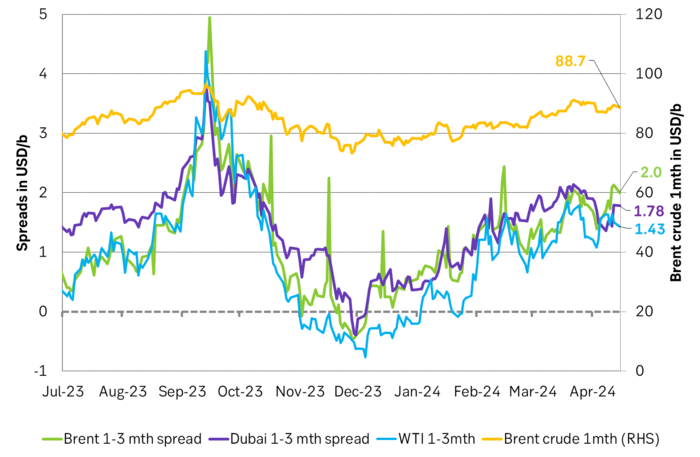
ICE gasoil forward curve has shifted from solid backwardation to front-end contango signaling diesel demand weakness. Leading to concerns for lower refinery runs and softer crude oil demand by refineries down the road.
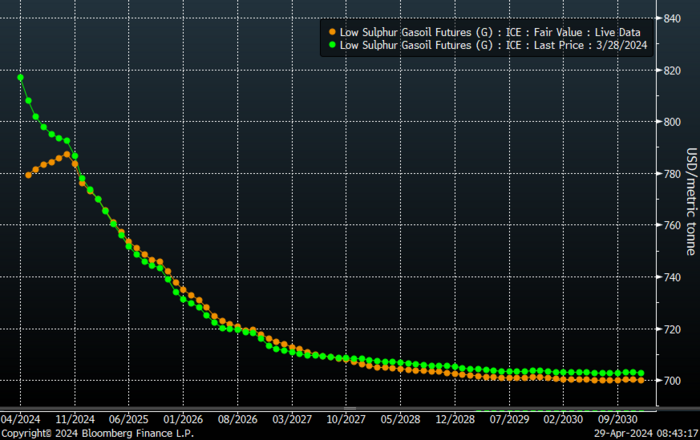
ARA gasoline crack has rallied towards while Gasoil crack has fallen back. Not a totally unusual pattern.
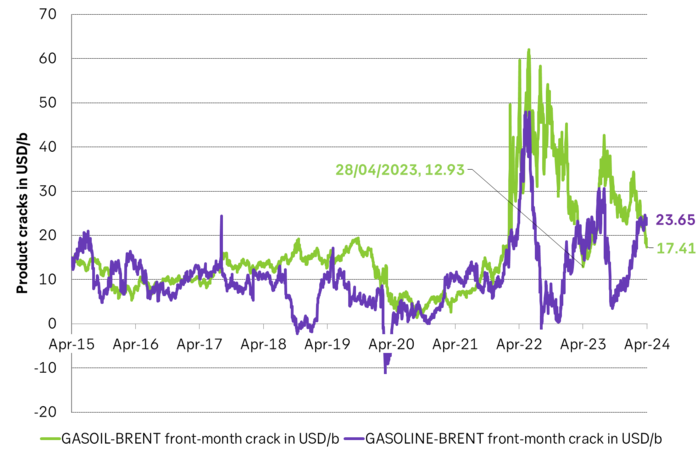
Proxy ARA refining margin with 40% gasoil crack, 40% gasoline crack and 20% bunker oil crack.

ARA diesel cracks saw the exact same pattern last year. Dipping low in April and May before rallying into the second half of the year. Diesel cracks have fallen back but are still clearly above normal levels both in spot and on the forward curve. I.e. the ”Russian diesel stress” hasn’t fully dissipated quite yet.
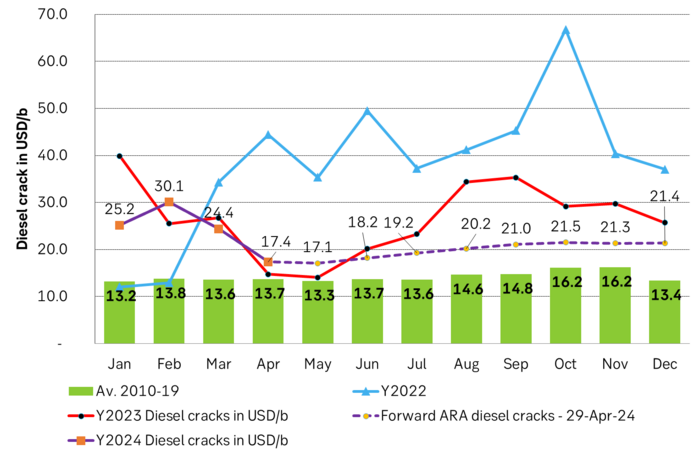
Net long specs fell back a little last week.

52-week ranking of net long speculative positions in Brent and WTI as well as 52-week ranking of the strength of the Brent 1-7 mth backwardation
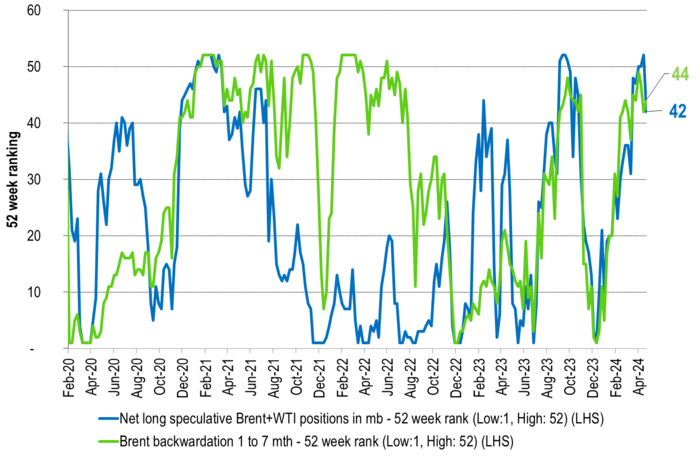
Analys
’wait and see’ mode

So far this week, Brent Crude prices have strengthened by USD 1.3 per barrel since Monday’s opening. While macroeconomic concerns persist, they have somewhat abated, resulting in muted price reactions. Fundamentals predominantly influence global oil price developments at present. This week, we’ve observed highs of USD 89 per barrel yesterday morning and lows of USD 85.7 per barrel on Monday morning. Currently, Brent Crude is trading at a stable USD 88.3 per barrel, maintaining this level for the past 24 hours.

Additionally, there has been no significant price reaction to Crude following yesterday’s US inventory report (see page 11 attached):
- US commercial crude inventories (excluding SPR) decreased by 6.4 million barrels from the previous week, standing at 453.6 million barrels, roughly 3% below the five-year average for this time of year.
- Total motor gasoline inventories decreased by 0.6 million barrels, approximately 4% below the five-year average.
- Distillate (diesel) inventories increased by 1.6 million barrels but remain weak historically, about 7% below the five-year average.
- Total commercial petroleum inventories (crude + products) decreased by 3.8 million barrels last week.
Regarding petroleum products, the overall build/withdrawal aligns with seasonal patterns, theoretically exerting limited effect on prices. However, the significant draw in commercial crude inventories counters the seasonality, surpassing market expectations and API figures released on Tuesday, indicating a draw of 3.2 million barrels (compared to Bloomberg consensus of +1.3 million). API numbers for products were more in line with the US DOE.
Against this backdrop, yesterday’s inventory report is bullish, theoretically exerting upward pressure on crude prices.
Yet, the current stability in prices may be attributed to reduced geopolitical risks, balanced against demand concerns. Markets are adopting a wait-and-see approach ahead of Q1 US GDP (today at 14:30) and the Fed’s preferred inflation measure, “core PCE prices” (tomorrow at 14:30). A stronger print could potentially dampen crude prices as market participants worry over the demand outlook.
Geopolitical “risk premiums” have decreased from last week, although concerns persist, highlighted by Ukraine’s strikes on two Russian oil depots in western Russia and Houthis’ claims of targeting shipping off the Yemeni coast yesterday.
With a relatively calmer geopolitical landscape, the market carefully evaluates data and fundamentals. While the supply picture appears clear, demand remains the predominant uncertainty that the market attempts to decode.
Analys
Also OPEC+ wants to get compensation for inflation

Brent crude has fallen USD 3/b since the peak of Iran-Israel concerns last week. Still lots of talk about significant Mid-East risk premium in the current oil price. But OPEC+ is in no way anywhere close to loosing control of the oil market. Thus what will really matter is what OPEC+ decides to do in June with respect to production in Q3-24 and the market knows this very well. Saudi Arabia’s social cost-break-even is estimated at USD 100/b today. Also Saudi Arabia’s purse is hurt by 21% US inflation since Jan 2020. Saudi needs more money to make ends meet. Why shouldn’t they get a higher nominal pay as everyone else. Saudi will ask for it

Brent is down USD 3/b vs. last week as the immediate risk for Iran-Israel has faded. But risk is far from over says experts. The Brent crude oil price has fallen 3% to now USD 87.3/b since it became clear that Israel was willing to restrain itself with only a muted counter attack versus Israel while Iran at the same time totally played down the counterattack by Israel. The hope now is of course that that was the end of it. The real fear has now receded for the scenario where Israeli and Iranian exchanges of rockets and drones would escalate to a point where also the US is dragged into it with Mid East oil supply being hurt in the end. Not everyone are as optimistic. Professor Meir Javedanfar who teaches Iranian-Israeli studies in Israel instead judges that ”this is just the beginning” and that they sooner or later will confront each other again according to NYT. While the the tension between Iran and Israel has faded significantly, the pain and anger spiraling out of destruction of Gaza will however close to guarantee that bombs and military strifes will take place left, right and center in the Middle East going forward.
Also OPEC+ wants to get paid. At the start of 2020 the 20 year inflation adjusted average Brent crude price stood at USD 76.6/b. If we keep the averaging period fixed and move forward till today that inflation adjusted average has risen to USD 92.5/b. So when OPEC looks in its purse and income stream it today needs a 21% higher oil price than in January 2020 in order to make ends meet and OPEC(+) is working hard to get it.
Much talk about Mid-East risk premium of USD 5-10-25/b. But OPEC+ is in control so why does it matter. There is much talk these days that there is a significant risk premium in Brent crude these days and that it could evaporate if the erratic state of the Middle East as well as Ukraine/Russia settles down. With the latest gains in US oil inventories one could maybe argue that there is a USD 5/b risk premium versus total US commercial crude and product inventories in the Brent crude oil price today. But what really matters for the oil price is what OPEC+ decides to do in June with respect to Q3-24 production. We are in no doubt that the group will steer this market to where they want it also in Q3-24. If there is a little bit too much oil in the market versus demand then they will trim supply accordingly.
Also OPEC+ wants to make ends meet. The 20-year real average Brent price from 2000 to 2019 stood at USD 76.6/b in Jan 2020. That same averaging period is today at USD 92.5/b in today’s money value. OPEC+ needs a higher nominal price to make ends meet and they will work hard to get it.
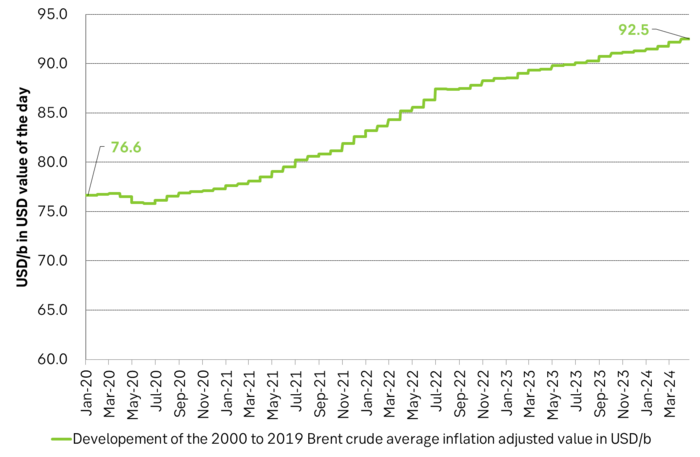
Inflation adjusted Brent crude price versus total US commercial crude and product stocks. A bit above the regression line. Maybe USD 5/b risk premium. But type of inventories matter. Latest big gains were in Propane and Other oils and not so much in crude and products

Total US commercial crude and product stocks usually rise by 4-5 m b per week this time of year. Gains have been very strong lately, but mostly in Propane and Other oils

Last week’s US inventory data. Big rise of 10 m b in commercial inventories. What really stands out is the big gains in Propane and Other oils
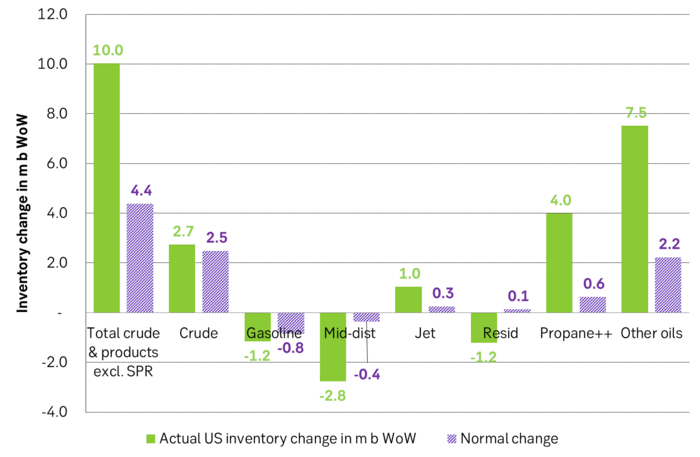
Take actual changes minus normal seasonal changes we find that US commercial crude and regular products like diesel, gasoline, jet and bunker oil actually fell 3 m b versus normal change.

-

 Nyheter4 veckor sedan
Nyheter4 veckor sedanGuldpriset når nytt all time high och bryter igenom 2300 USD
-

 Nyheter3 veckor sedan
Nyheter3 veckor sedanUSAs stigande konsumtion av naturgas
-

 Nyheter4 veckor sedan
Nyheter4 veckor sedanCentralbanker fortsatte att köpa guld under februari
-

 Nyheter4 veckor sedan
Nyheter4 veckor sedanKakaomarknaden är extrem för tillfället
-

 Nyheter4 veckor sedan
Nyheter4 veckor sedanHur mår den svenska skogsbraschen? Två favoritaktier
-

 Nyheter4 veckor sedan
Nyheter4 veckor sedanBetydande underskott i utbudet av olja kan få priset att blossa upp
-
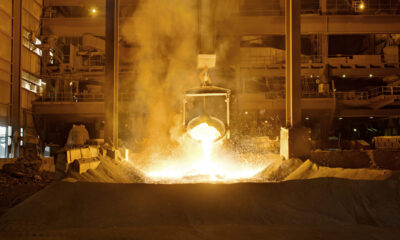
 Nyheter2 veckor sedan
Nyheter2 veckor sedanFortum och Vargön Alloys tecknar femårigt avtal om kärnkraftsel
-

 Analys2 veckor sedan
Analys2 veckor sedanBrace for Covert Conflict


